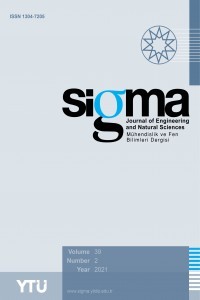TRIP OPTIMIZATION FOR PUBLIC TRANSPORTATION SYSTEMS WITH LINEAR GOAL PROGRAMMING (LGP) METHOD
TRIP OPTIMIZATION FOR PUBLIC TRANSPORTATION SYSTEMS WITH LINEAR GOAL PROGRAMMING (LGP) METHOD
___
- [1] Dantzig G.B., (1948) Programming in a Linear Structure. Comptroller, United States Air Force, Washington DC.
- [2] Charnes A. and Cooper, W.W., (1961) Management Models and the Industrial Applications of Linear Programming. John Wiley, New York
- [3] Lee S.M., (1972) Goal Programming for Decision Analysis. Auerbach, Philadelphia.
- [4] Ignizio J.P., (1976) Goal Programming and Extensions. D. C. Heath and Company, Lexington
- [5] Romero C., (1982) On Misconceptions in Goal Programming. The Journal of the Operational Research Society, 42, 927-928.
- [6] Schniederjans M.J., (1984) Linear Goal Programming. Petrocelli, Princeton.
- [7] Tamiz M. and Jones D.F., (1996) Goal Programming and Pareto Efficiency. Journal of Information and Optimization Sciences, 17, 291-307. http://dx.doi.org/10.1080/02522667.1996.10699283.
- [8] Orumie, U. C. and Ebong, D., (2014) A Glorious Literature on Linear Goal Programming Algorithms. American Journal of Operations Research, 2014.
- [9] Dağdeviren, M. Akar, D. and Kurt, M. (2004). “İş Değerlendirme, Faktör Derece Puanlarının Belirlenmesinde Hedef Programlama Yönteminin Kullanılması”, Gazi Üniversitesi Mühendislik Fakültesi Dergisi, 19(1), 91.
- [10] Alp S., (2008) Doğrusal Hedef Programlama Yönteminin Otobüsle Kent İçi Toplu Taşıma Sisteminde Kullanılması. İstanbul Ticaret Üniversitesi Fen Bilimleri Dergisi, 1: 13 s. 73-91.
- [11] Ignizio J., (1985) Introduction to Goal Programming, Sage Publications Inc., USA.
- [12] Rardin R. L., (1998) Optimization in Operations Research (Vol. 166). Upper Saddle River, NJ: Prentice Hall
- [13] Hillier F. S. and Lieberman, G. J., (1990) Introduction to Stochastic Models in Operations Research. McGraw-Hill Companies.
- [14] Sharma N. K. and Bhatia, O. S. (2016). Application of Linear Goal Programming (LGP) To Case Study Provider Quota Distribution. Journal of Mechanical and Civil Engineering (IOSR-JMCE). 13(2), 38-40.
- [15] Bassey, U.N. and Effanga, E.O. (2008). A Linear Goal Programming Model for the Linear Absolute Value Regression Problem. Journal of Modern Mathematics and Statistics 2(3): 123-125.
- [16] Ahern, A and Anandarajah, G. (2006). “Railway Projects Prioritisation for Investment: Application on Goal Programming”, Transport Policy, 14(1), 70-80.
- [17] Shivastava, P. (2007). “Design of Feeder Route Network Using Combined Genetic Algorithm and Specialized Repair Heuristic”, Journal of Public Transportation, 10(2), 109-133.
- [18] Leung Stephen, C.H., Wu, Y and Lai, K.K. (2006). “Cross-Border Logistics with Fleet Management: A Goal Programming Approach”, Computers & Industrial Engineering, 50(1), 263-272.
- [19] Abd El-Wahed, Waiel F. and Sang M. L. (2006). “Interactive Fuzzy Goal Programming for Multi-Objective Transportation Problems”, The International Journal of Management Science (Omega), 34(2), 158-166.
- [20] Braysy, Olli AND Gendreau, (2005). “Vehicle Routing with Time Windows, Part I: Route Construction and Local Search Algorithms”, Transport Science, 39(1), 104-118.
- [21] Tekin, S., Köfteci, S. and Aydın, M. M. (2017). Schedule Optimization of Public Transportation System by Using Linear Goal Programming Method. Conference of the International Journal of Arts & Sciences. 10(02), 183-184.
- [22] Deri A., (2012) Akıllı Kart Verileri Kullanılarak Toplu Ulaşım Yolculuk Talebinin Belirlenmesi Ve Sefer Çizelgeleme Optimizasyonu. Yüksek Lisans Tezi, Dokuz Eylül Üniversitesi Fen Bilimleri Enstitüsü, İzmir.
- [23] Uludağ, N., (2010) Bulanık Optimizasyon Ve Doğrusal Hedef Programlama Yaklaşımları İle Otobüs Hatlarının Modellenmesi. Doktora Tezi, Pamukkale Üniversitesi Fen Bilimleri Enstitüsü, Denizli.
- [24] Aydin M.M., Yıldırım M.S., Aydin R., Arslan Y., (2016). "Effect of different passenger characteristics and bus types on boarding times at bus-stops", Journal of Engineering Research and Applied Science, 5(2), 499-599.
- [25] BMC, (2018). http://www.bmc.com.tr/wp-content/uploads/2015/01/BMC-ProCity.pdf
- [26] Sevim İ., Tekiner Moğulkoç H., Güler M. G., Mutlu Z. P., (2016). “Automated Vehicle Scheduling System: A Case Study of Metrobus System”, Sigma J Eng & Nat Sci, 7(1), 1-7.
- ISSN: 1304-7191
- Başlangıç: 1983
- Yayıncı: Yıldız Teknik Üniversitesi
SYSTEMATICAL REVIEW ON THE NUMERICAL SIMULATIONS OF LASER POWDER BED ADDITIVE MANUFACTURING
Melih Cemal KUŞHAN, Özgür POYRAZ, Yağız UZUNONAT, Sezan ORAK
Payam MAJEDI, Semet ÇELİK, Suat AKBULUT
Maria Lígia CHUERUBIM, Irineu DA SILVA
Barış ÖZLÜ, Halil DEMİR, Mustafa TÜRKMEN, Süleyman GÜNDÜZ
ANALYTICAL AND NUMERICAL STUDY OF MICROPOLAR FLUID FLOW IN A POROUS PLATE DUE TO LINEAR STRETCHING
Nozar AKBARI, Mosayeb GHOLINIA, Saber GHOLINIA, Soheil DABBAGHIAN, Hossein JAVADI, Davood Domairry GANJI
Yakup Emre ÇORUHLU, Bayram UZUN
Mehmet Erdi KORKMAZ, Mustafa GÜNAY
Ali İhsan ÇELİK, Mehmet Metin KÖSE, Tahir AKGÜL, Ahmet Celal ALPAY
AN EMPIRICAL APPROACH FOR PROPELLER TIP VORTEX CAVITATION NOISE
Savaş SEZEN, Ali DOĞRUL, Şakir BAL
THE MOST APPROPRIATE EARTHQUAKE RECORD GROUPS FOR DYNAMIC ANALYSIS OF A BUILDING
